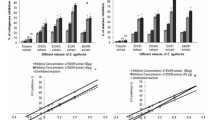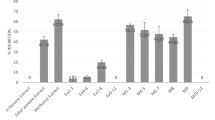Abstract
Human neutrophil elastase (HNE), a serine protease with broad target specificity, is the only enzyme responsible for the degradation of elastin which is an insoluble elastic fibrous protein in animal connective tissue. Biologically, elastase activity significantly increased with age, which results in a reduced skin elasticity and in the appearance of wrinkles or stretchmarks. In the course of our screening program for HNE inhibitors from natural source, the MeOH extract of Ilex paraguariensis leaves showed strong HNE inhibitory effect. Bioassay-guided fractionation led to the isolation of a new pyrrole alkaloid (1), along with seventeen known compounds (2–18) from the MeOH extract of Ilex paraguariensis leaves, and their chemical structures were elucidated on the basis of spectroscopic analysis. All isolated compounds were evaluated for HNE inhibitory activity, and the result demonstrated that dicaffeoylquinic acid derivatives (12, 13, 14, 15 and 16) and flavonoids (8 and 17) exhibited potent HNE inhibitory activity with IC50 values ranging from 1.4 to 7.3 µM.
Similar content being viewed by others
References
Abreu, P. M., Braham, H., Ben-Jannet, H., Mighri, Z., and Matthew, S., Antioxidant compounds from Ebenus pinnata. Fitoterapia, 78, 32–34 (2007).
Alikaridis, F., Natural constituents of Ilex species. J. Ethnopharmacol., 20, 121–144 (1987).
Antonicelli, F., Bellon, G., Debelle, L., and Hornebeck, W., Elastin-elastases and inflamm-aging. Curr. Top. Dev. Biol., 79, 99–155 (2007).
Ban, J. Y., Cho, S. O., Jeon, S. Y., Bae, K., Song, K. S., and Seong, Y. H., 3, 4-Dihydroxybenzoic acid from Smilacis chinae rhizome protects amyloid beta protein (25–35)-induced neurotoxicity in cultured rat cortical neurons. Neurosci. Lett., 420, 184–188 (2007).
Basnet, P., Matsushige, K., Hase, K., Kadota, S., and Namba, T., Four di-O-caffeoyl quinic acid derivatives from propolis. Potent hepatoprotective activity in experimental liver injury models. Biol. Pharm. Bull., 19, 1479–1484 (1996).
Benedek, B., Kopp, B., and Melzig, M. F., Achillea millefolium L. s.l. — Is the anti-inflammatory activity mediated by protease inhibition? J. Ethnopharmacol., 113, 312–317 (2007).
Bernstein, E. F. and Uitto, J., The effect of photodamage on dermal extracellular matrix. Clin. Dermatol., 14, 143–151 (1996).
Chin, Y. W., Lim, S. W., Kim, S. H., Shin, D. Y., Suh, Y. G., Kim, Y. B., Kim, Y. C., and Kim, J., Hepatoprotective pyrrole derivatives of Lycium chinense fruits. Bioorg. Med. Chem. Lett., 13, 79–81 (2003).
Choi, S. Z., Lee, S. O., Choi, S. U., and Lee, K. R., A new sesquiterpene hydroperoxide from the aerial parts of Aster oharai. Arch. Pharm. Res., 26, 521–525 (2003).
Elisabeth, P., Yoshioka, M., Yamauchi, Y., and Saito, M., Infrared and nuclear magnetic resonance spectrometry of caffeine in roasted coffee after separation by preparative supercritical fluid chromatography. Anal. Sci., 7, 427–431 (1991).
Filip, R., Lotito, S. B., Ferraro, G., and Fraga, C. G., Antioxidant activity of Ilex paraguariensis and related species. Nutr. Res., 20, 1437–1446 (2000).
Filip, R., Lopez, P., Giberti, G., Coussio, J., and Ferraro, G., Phenolic compounds in seven South American Ilex species. Fitoterapia, 72, 774–778 (2001).
Gorgen, M., Turatti, K., Medeiros, A. R., Buffon, A., Bonan, C. D., Sarkis, J. J., and Pereira, G. S., Aqueous extract of Ilex paraguariensis decreases nucleotide hydrolysis in rat blood serum. J. Ethnopharmacol., 97, 73–77 (2005).
Gorzalczany, S., Filip, R., Alonso, M. R., Mino, J., Ferraro, G. E., and Acevedo, C., Choleretic effect and intestinal propulsion of ‘Mate’ (Ilex paraguariensis) and its substitutes or adulterants. J. Ethnopharmacol., 75, 291–294 (2001).
Gosmann, G., Guillaume, D., Taketa, A. T., and Schenkel, E. P., Triterpenoid saponins from Ilex paraguariensis. J. Nat. Prod., 58, 438–441 (1995).
Grigioni, G, Carduzam, F., Iruruetam, M., and Pensel, N., Flavour characteristics of Ilex paraguariensis infusion, a typical Argentine product, assessed by sensory evaluation and electronic nose. J. Sci. Food Agric., 84, 427–432 (2004).
Gugliucci, A. and Stahl, A. J., Low density lipoprotein oxidation is inhibited by extracts of Ilex paraguariensis. Biochem. Mol. Biol. Int., 35, 47–56 (1995).
Han, J. T., Bang, M. H., Chun, O. K., Kim, D. O., Lee, C. Y., and Baek, N. I., Flavonol glycosides from the aerial parts of Aceriphyllum rossii and their antioxidant activities. Arch. Pharm. Res., 27, 390–395 (2004).
Hung, T. M., Thuong, P. T., Youn, U. J., Zhang, X. F., Min, B. S., Woo, M. H., Lee, H. K., and Bae, K. H., Antioxidant activities of phenolic derivatives from Dipsacus asper Wall. (II). Nat. Prod. Sci., 14, 107–112 (2008).
Kim, Y. C., Kim, M. Y., Takaya, Y., Niwa, M., and Chung, S. K., Phenolic antioxidants isolated from Mulberry leaves. Food Sci. Biotechnol., 16, 854–857 (2007).
Kuo, W. L., Huang, Y. L., Wang, S. T., Ni, C. L., Shien, B. J., and Chen, C. C., Chemical constituents of Trema orientalis. J. Chin. Med., 18, 27–36 (2007).
Lee, J. Y., Moon, S. O., Kwon, Y. J., Rhee, S. J., Park, H. R., and Choi, S. W., Identification and quantification of anthocyanins and flavonoids in Mulberry (Morus sp.) cultivars. Food Sci. Biotechnol., 13, 176–184 (2004).
Lee, K. K., Kim, J. H., Cho, J. J., and Choi, J. D., Inhibitory effects of 150 plant extracts on elastase activity, and their anti-inflammatory effects. Int. J. Cosmet. Sci., 21, 71–82 (1999).
Martinet, A., Hostettmann, K., and Schutz, Y., Thermogenic effects of commercially available plant preparations aimed at treating human obesity. Phytomedicine, 6, 231–238 (1999).
Melzig, M. F., Löser, B., and Ciesielski, S., Inhibition of neutrophil elastase activity by phenolic compounds from plants. Die Pharmazie, 56, 967–970 (2001).
Oh, S. R., Jung, K. Y., and Lee, H. K., In vitro anticomplementary activity of phenylpropanoids from Agastache rugosa. Kor. J. Pharmacogn., 27, 20–25 (1996).
Ohem, N. and Holzl, J., Some new investigations on Ilex paraguariensis: flavonoids and triterpenes. Planta Med., 54, 576 (1988).
Puizina-Ivic, N., Skin aging. Acta Dermatoven. APA., 17, 47–54 (2008).
Saldana, M. D. A., Zetzl, C., Mohamed, R. S., and Brunner, G., Extraction of methylxanthines from guarana seeds, mate leaves, and cocoa beans using supercritical carbon dioxide and ethanol. J. Agric. Food Chem., 50, 4820–4826 (2002).
Seite, S., Zucchi, H., Septier, D., Igondjo-Tchen, S., Senni, K., and Godeau, G., Elastin changes during chronological and photo-ageing: the important role of lysozyme. J. Eur. Acad. Dermatol. Venereol., 20, 980–987 (2006).
Starcher, B., Aycock, R. L., and Hill, C. H., Multiple roles for elastic fibers in the skin. J. Histochem. Cytochem., 53, 431–443 (2005).
Tatefuji, T., Izumi, N., Ohta, T., Arai, S., Ikeda, M., and Kurimoto, M., Isolation and identification of compounds from Brazilian propolis which enhance macrophage spreading and mobility. Biol. Pharm. Bull., 19, 966–970 (1996).
Teramachi, F., Koyano, T., Kowithayakorn, T., Hayashi, M., Komiyama, K., and Ishibashi, M., Collagenase inhibitory quinic acid esters from Ipomoea pes-caprae. J. Nat. Prod., 68, 794–796 (2005).
Wiltried, M., Klaus, N., and Lin, Z. F., Elastic fibre arrangement in the skin of the pig. Arch. Derm. Res., 270, 397–401 (1994).
Yang, Y. P., Cheng, M. J., Teng, C. M., Chang, Y. L., Tsai, I. L., and Chen, I. S., Chemical and anti-platelet constituents from Formosan Zanthoxylum simulans. Phytochemistry, 61, 567–572 (2002).
Zhao, N., Gao, H. Y., Sun, B. H., and Wu, L. J., Chemical constituents from the leaves of Camellia sinensis. J. ShenYang Pharm. Univ., 24, 211–214 (2007).
Zhu, X., Dong, X., Wang, Y., Peng, J., and Luo, S., Phenolic compounds from Viburnum cylindricum. Helv. Chim. Acta, 88, 339–342 (2005).
Author information
Authors and Affiliations
Corresponding author
Rights and permissions
About this article
Cite this article
Xu, GH., Kim, YH., Choo, SJ. et al. Chemical constituents from the leaves of Ilex paraguariensis inhibit human neutrophil elastase. Arch. Pharm. Res. 32, 1215–1220 (2009). https://doi.org/10.1007/s12272-009-1905-7
Received:
Revised:
Accepted:
Published:
Issue Date:
DOI: https://doi.org/10.1007/s12272-009-1905-7




